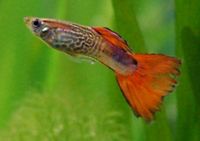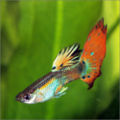Guppy (Poecilia reticulata)
From The Aquarium Wiki
Poecilia reticulata
38 Litres (10 US G.)
5.1-6.4cm (2-2.5 ")
7.0 - 8.0
20-27.8°C (68 -82 °F)
5-20 °d
1:3 M:F
2-4 years
Family
Poeciliidae
This animal is available captive bred
Contents
Additional names
- Guppy, Fancy Guppy, Millions Fish, JAW Fish, Rainbow Fish
Additional scientific names
- Acanthophacelus guppii, Acanthophacelus reticulatus, Girardinus guppii, Girardinus reticulatus, Haridichthys reticulatus, Heterandria guppyi, Lebistes poecilioides, Lebistes poeciloides, Lebistes reticulatus, Poecilia reticulate, Poecilia reticulatus, Poecilioides reticulatus
Origin
- Native to Venezuela, Barbados, Trinidad, northern Brazil and the Guyanas but introduced into many other countries. While primarily a freshwater fish, it will survive in full strength seawater if acclimated carefully.
Sexing
- Male guppies are much more colorful than females; in domesticated strains, they also have much longer fins than females. Aside from coloration, sex can also be determined by the presence of the gonopodium organ, a modified anal fin used to inseminate the female during mating. Mature females also have a dark gravid spot near their vent; if she is pregnant, the gravid spot will be a large, dark brown, or more commonly, black spot. If she is not pregnant, the gravid spot will be a smaller dot ranging in color from brown to yellow-orangish, depending on the individual fish. In some specimens, as pregnancy advances to the last few days before birth, the eyes of the fry may be visible in place of the gravid spot.
Breeding
- Guppies are notoriously easy to breed and will inevitably reproduce if both sexes are present (hence the JAW - 'just add water' - name); even an all-female group can still become a breeding colony if the females had previously been exposed to males, as female guppies can store sperm from previous matings and use it to fertilize several subsequent broods.The gestation period typically lasts 3-4 weeks before relatively large fry are produced; the parents may eat the fry, and thus they are best moved to another tank of their own to be raised. If the fry are not going to be separated from the adults, it's a good idea to add large quantities of floating plants to the aquarium, as they will provide shelter and food for small fry (which hide near the surface when young). Pregnant females should not be put into a net breeder or trap shortly prior to giving birth, as this can stress them to the point that they abort the fry. Fry can be fed powdered fry food, baby brine shrimp, or microworms immediately and can reach maturity within two months under ideal conditions.
Tank compatibility
- Guppies are very docile fish that can be mixed with a variety of hard water tolerant species. Fin nippers should be avoided with the fancy varieties, and large fish should likewise be avoided unless the guppies are intended to serve as a live food source; this is particularly important for the smaller wild type guppies. Male bettas regularly confuse fancy guppies for rival males and should not be mixed with them. Male guppies are constantly obsessed with reproduction, and females in the tank should outnumber males three to one or more to prevent them from being unduly harassed; female non-guppy livebearers may be similarly harassed.
Diet
- Guppies are omnivores and will eat virtually everything offered, from algae to flakes to small live foods. They will also eat some blanched vegetables like courgette, cucumber or lettuce. Live and frozen foods will encourage better health, color, and vitality as they do most other fishes.
Feeding regime
- Guppies typically eat constantly in the wild and benefit from several small feedings throughout the day.
Environment specifics
- Guppies are not overly picky about their tank layout as long as the water is reasonably hard and alkaline, though dense plant growth will improve fry survival rates. The long finned fancy varieties should not be kept with sharp ornaments that may snag on their fins. Many fancy varieties are infamously delicate and require excellent water quality; salt can be used to discourage illness in these fishes but will severely limit what plants can be kept with them.
Notes
- Guppies have been extensively inbred to produce the fancy forms, and thus these fancy forms are often quite delicate; wild type guppies are much better beginner fishes but are harder to find. Feeder guppies (which are usually fancy guppy culls which revert to wild type coloration) are frequently diseased when purchased, but if nursed back to health are also markedly hardier than normal fancy guppies.
Pictures
Videos
| 3rd International Guppy Show 2008: | King Tiger Fancy Guppy: |
Links
- Fishbase (Mirrors:
 )
)






